| |
Large Pictures 2 Chapter 11.3 |
 |
Spear and lance points from Nydam
in the Schleswig museum |
|
| |
| |
|
| |
| |
 |
A quite good excerpt of the sword types as defined by Elis Behmer |
| |
|
|
|
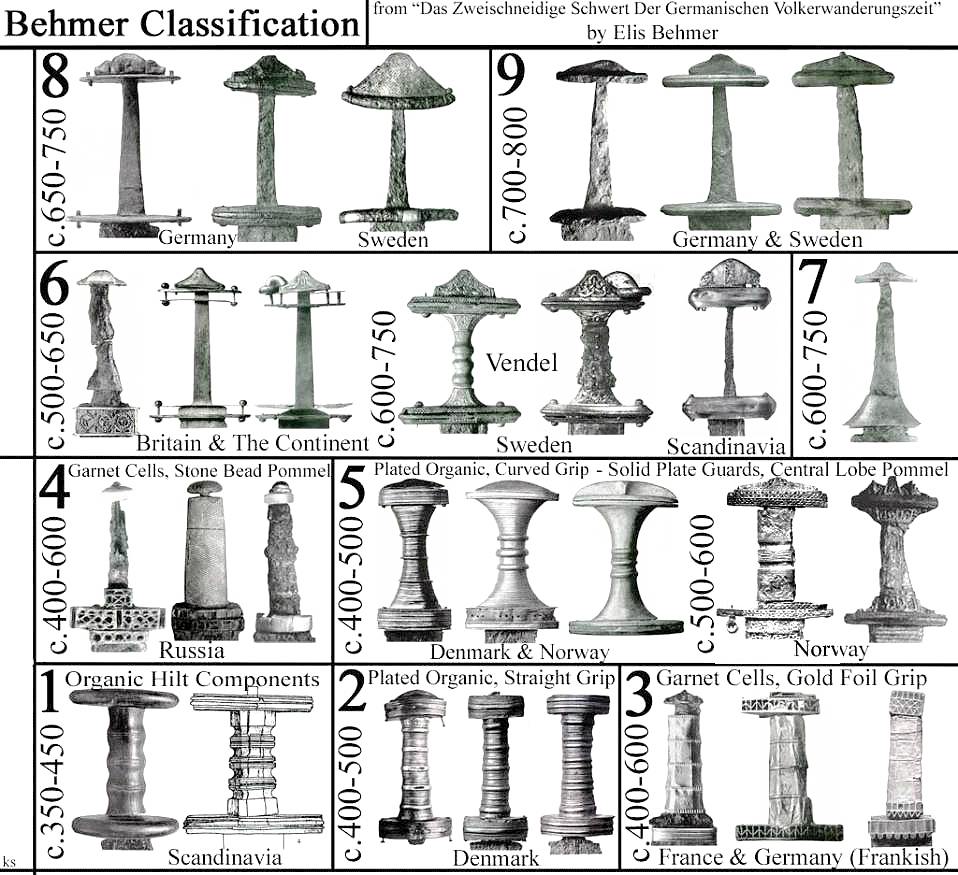 |
| Link to text |
Source: Some Polish sword site; can't give details, sorry. |
|
| |
| |
 |
Some close-ups of the Staffordshire hoard pommels. |
| |
|
|
|
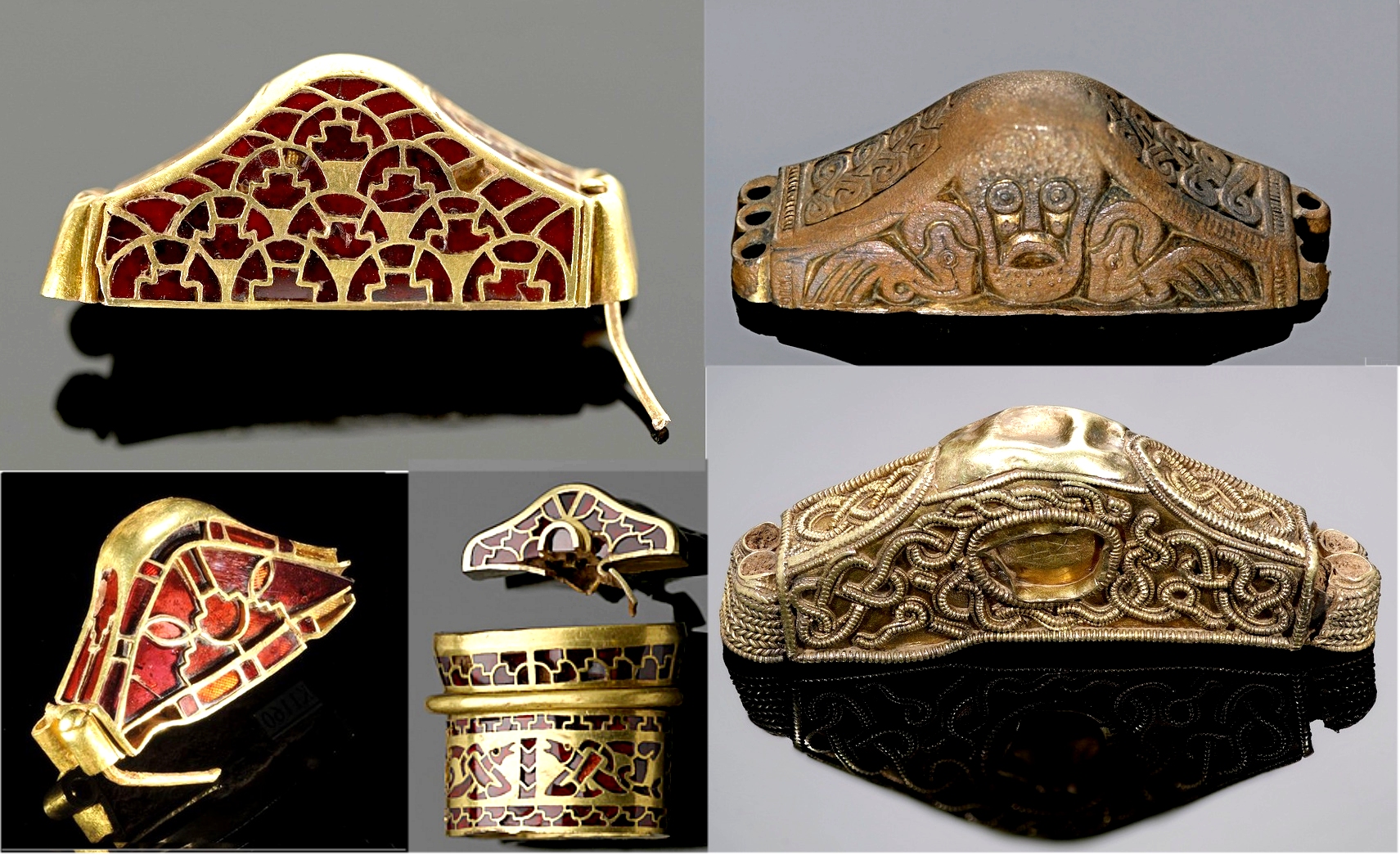 |
| Link to text |
Source: Internet at large (British museum, Birmingham museum, National Geographic, newspapers, ...)
|
|
| |
| |
 |
A very nice Pyramid garnet pommel, displayed in the Stockholm
Archaeological Museum.
It is actually the "Hög Edsten" pommel mentioned in the main
text. |
|
| |
| |
 |
 |
| Link to text |
Source: Photographed 2015 in the Stockhol museum |
|
| |
| |
 |
A very involved pommel with different designs on front and back.
Seems to be gilded bronze
and was found in Aldbrough; ca. 600 AD - 650 AD. |
| |
|
|
|
|
| |
| |
 |
A rather good pyramid garnet pommel coming up for sale at an
auction in Jan 2018.
So for just around 4.000 Euro you couild own such a thing.
Well, not quite. It was sold on
Feb, 26th 2019 for £ 13.000.- (about $ 17.000.-) |
| | |
| |
|
| |
| |
 |
This is a drawing of a Niederstotzingen Alamanni grave where
three people were buried.
Each person was inhumated with a big sword, a sax, and many smaller items.
And one of
the persons was a woman! |
|
| |
| |
|
| |
| |
| |
 |
In the next picture you can "see" the actual content of the graves as displayed
in the
Württemberg State Museum, Stuttgart, Germany. What you
actually can see
quite clearly (in contrast tot the grave things) is that the museum has succumbed to
the dreaded
Keep-things-in-the-dark
disease, and you see mostly reflections. |
| | |
|
|
|
|
| |
| |
 |
Type
8 and 9 swords according to Behmer. From around 650 - 800.
Behmer says almost nothing to the blades but they are
most likely not pattern welded. |
|
| |
| |
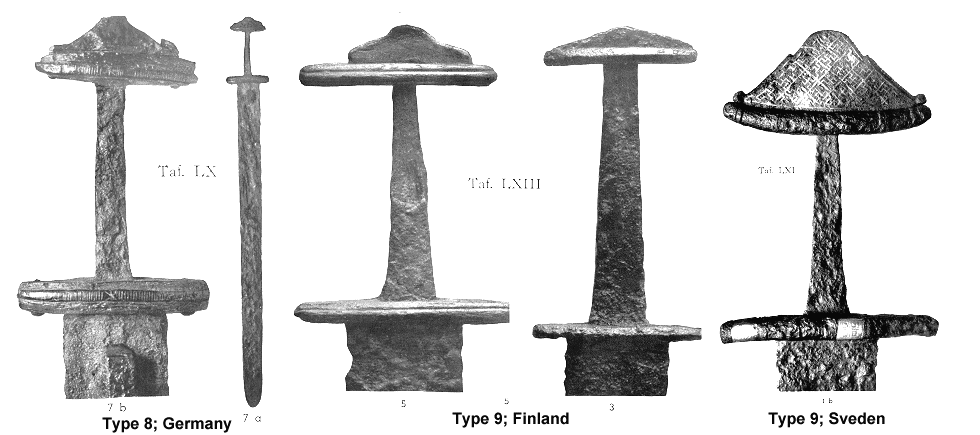 |
| Link to text |
Source: Internet at large (British museum, Birmingham museum, National Geographic, newspapers, ...)
|
|
| |
| |
 |
A pyramid pommel sword from some bog (probably Nydam ). |
| | |
| |
|
| |
| |
 |
This one is displayed in the National museum in Helsinki, Finland.
Note that it is very similar to the Copenhagen one above. |
| | |
| |
|
| |
| |
 |
This one is displayed in National museum in Rome, Italy. It was found in Grave
1 of the Necropolis of Nocera, Umbra. It appears that the ring has been added later |
| |
|
| |
|
| |
| |
 |
You dont' have to go very far from where I live to find fancy sword hilts including
the pommel ring type.
The following pictures were taken from the
(500+ page) PhD thesis of Ulrich Lehmann
who did a detailed study (involving fancy technology like X-ray tomography) of some swords from around the 7th / 8th
century and found in Westphalia, North Germany |
| | |
| |
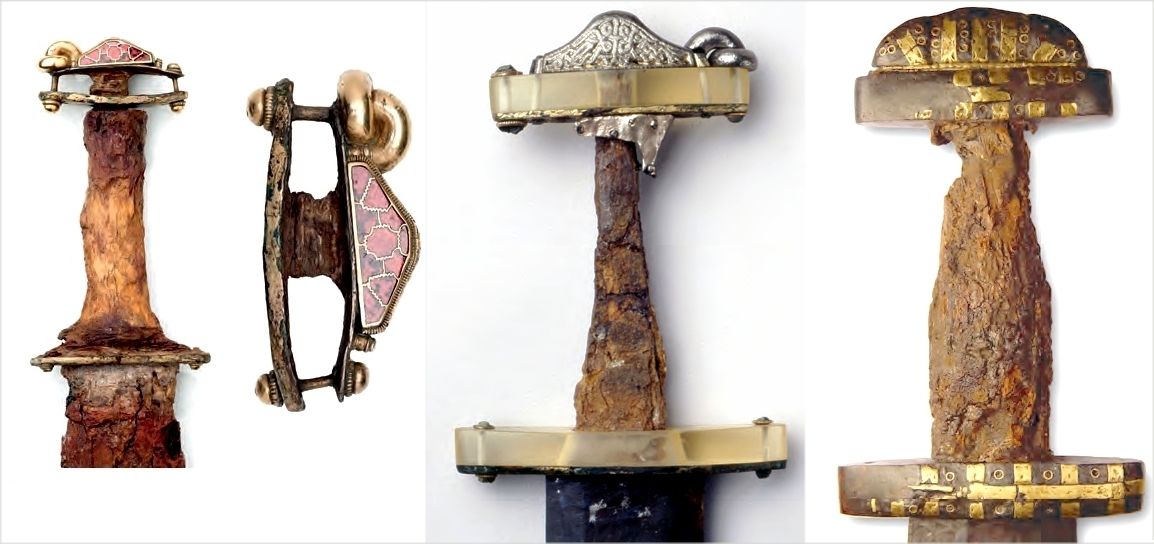 |
Left: Found around Krefeld; 520 - 530 AD.
Middle: Found around Beckum; 590 – 610
AD.
Right: : Found around Dorsten-Lembeck; 730 – 800 AD. |
| Source: Lehmann thesis |
|
| |
| |
 |
Some pictures from the large hoard of Roman iron from Künzing, Bavaria, Germany. The stuff was most
likely buried after the Alemanni took the
Roman fortress there in 259 AD. |
|
| |
| |
|
| |
| |
 |
Here a few of the pugios
displayed in the Archäologische Staatssammlung, München, Germany. |
| | |
| |
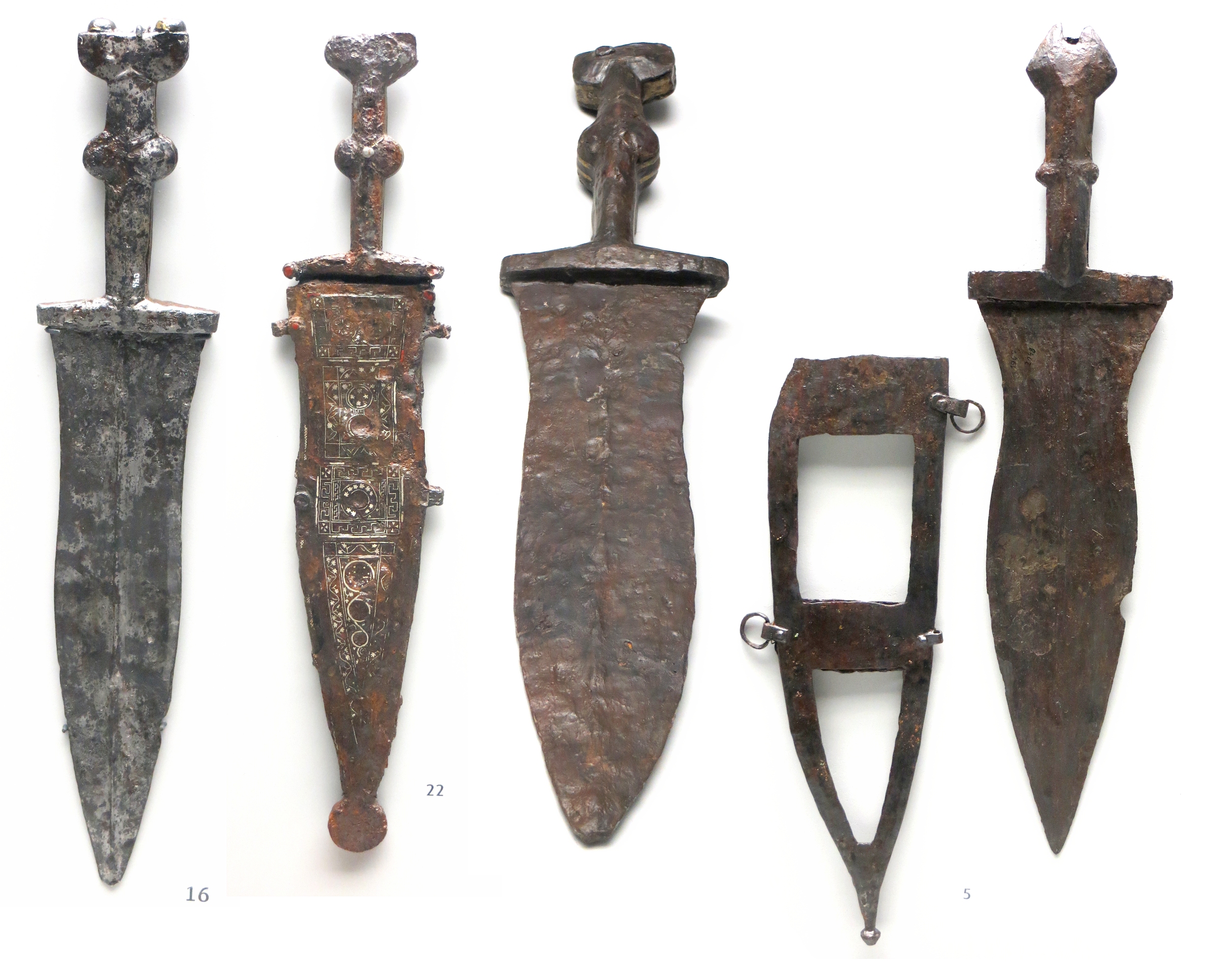 |
| Source: Photographed (2014) in the Archäologischen Staatssammlung, München,
Germany |
|
| |
| |
 |
Here are stereo pictures of details in the famous Rococo Church
in Ottobeuren, Germany.
Tip: If you can't see it three-dimensionally after some effort (moving your head a bit back
and forth, left and right),
print the picture (or transfer them to a picture processing program), cut out one part
and move it around a bit while looking.
Start with the two pictures closer together.
If you see two pictures, move
one part until both images coincide. The effect is rather spectacular. |
| | |
| |
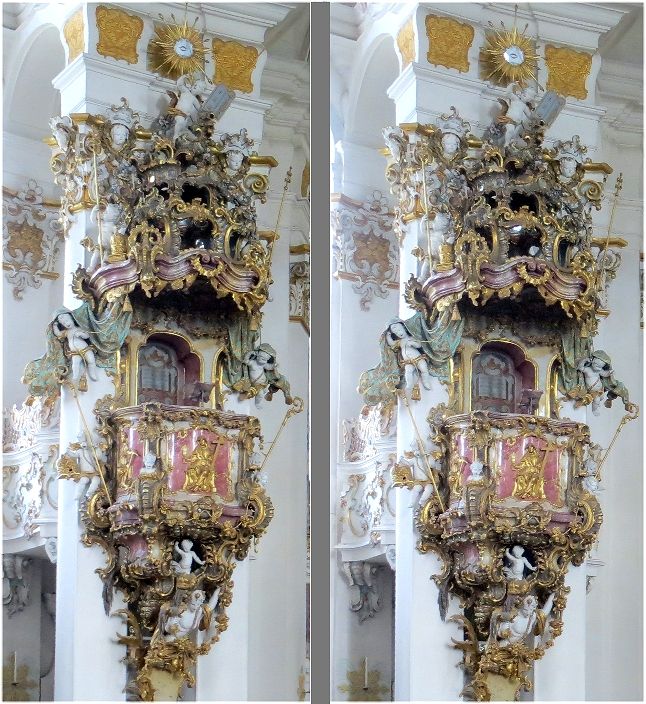 |
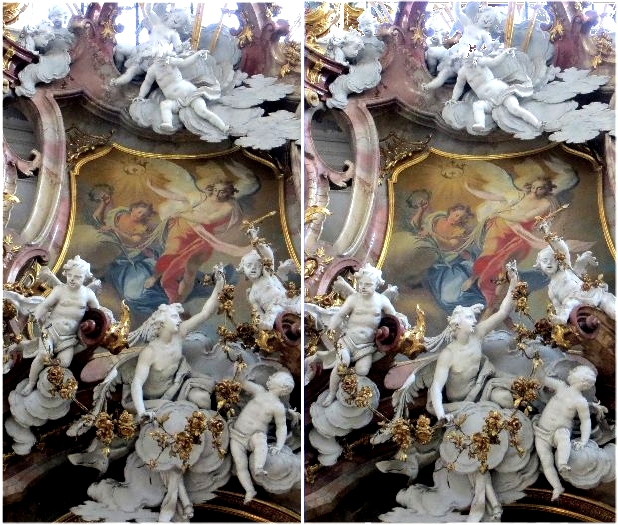 |
| Link to text |
Source: Photographed (2014) in the Benedictine Abbey Church in Ottobeuren |
|
| |
| |
 |
This sword is shown in the Mainfränkisches Museum, Würzburg,
Germany. It was found in the Würzburg area
and dates (presumably) to the 6th century if we go by the Behmer classification. Note that its hilt has silver inlays
("Tauschierungen")
and that the well preseved blald shows no obvious traces of pattern welding. |
|
 |
Looking closely a the corroded parts of the tang (see the inset) reveals the all-telling striped
bar structure
and we may savely assume that the blade was pattern welded with one or two of the striped bars contuing
into the tang region. |
| |
| |
| |
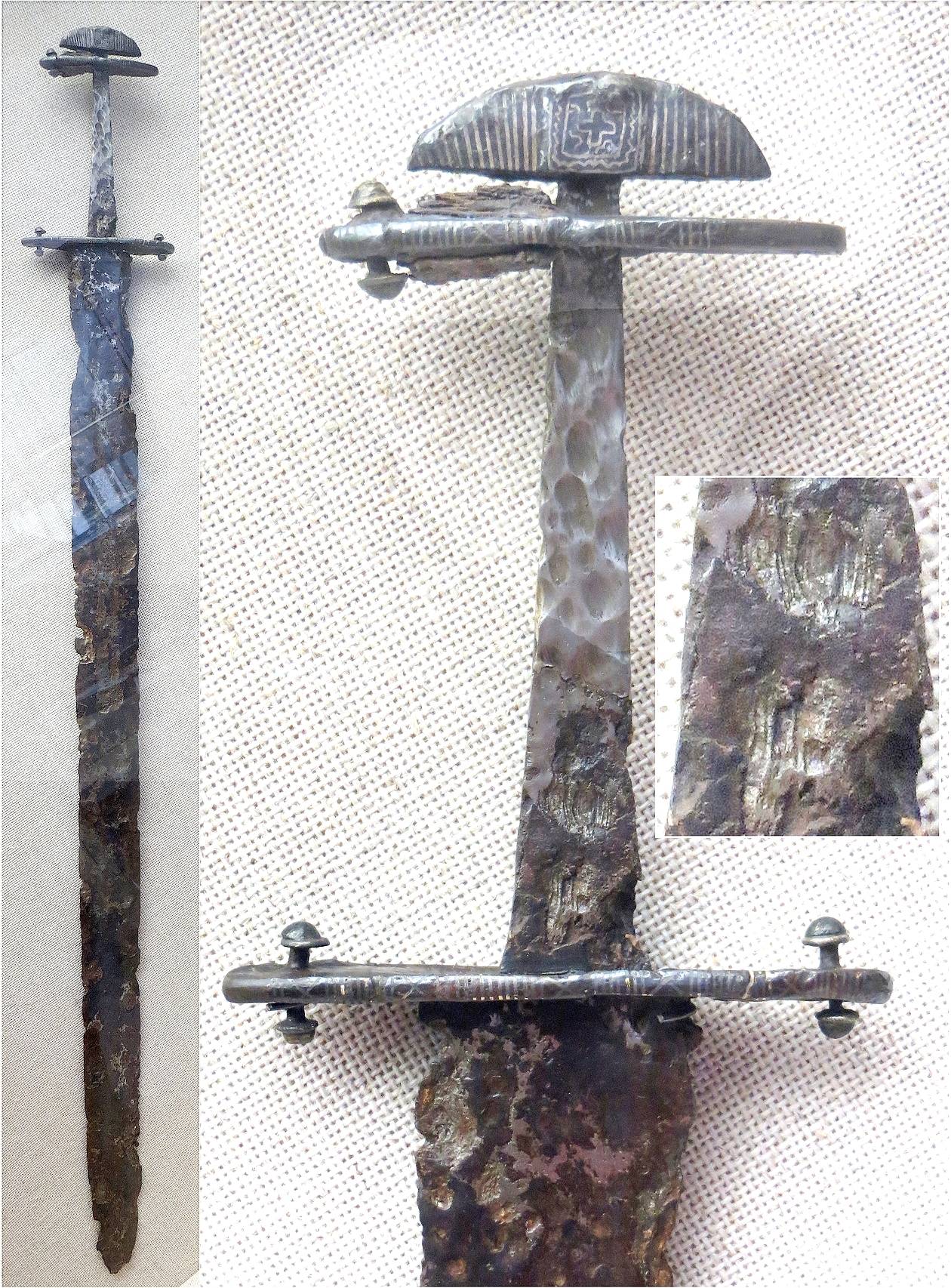 |
| Link to text |
Source: Photographed 2014 in the Mainfränkisches Museum, Würzburg, Germany
|
|
| |
| |
 |
Details of the three Alemanni
swords from Memmingen. Have these blades been made by pattern welding? |
|
 |
The left-hand side blade does not show obvious signs of pattern welding. The cracks indicated
might denote
the weld line of striped rods but that is not certain. Nevertheless I would bet that pattern welding was
involved.
The middle blade shows the telling-all herringbone pattern in its center and thus "classical" Alemanni
pattern
welding. The blade on the right-hand side shows tell-tale marks pattern welding marks only on the second
look. Welding seams between rods can be found (marked by arrows), and even a faint trace of half a herring
bone pattern
can be discerned in some small part.. |
| | |
|
|
|
|
| |
| |
 |
Here you find large pictures of the four gold-hilt spatha on
display in the Württemberg State Museum |
|
 |
The Entringen gold-hilt spatha: |
| | |
|
|
|
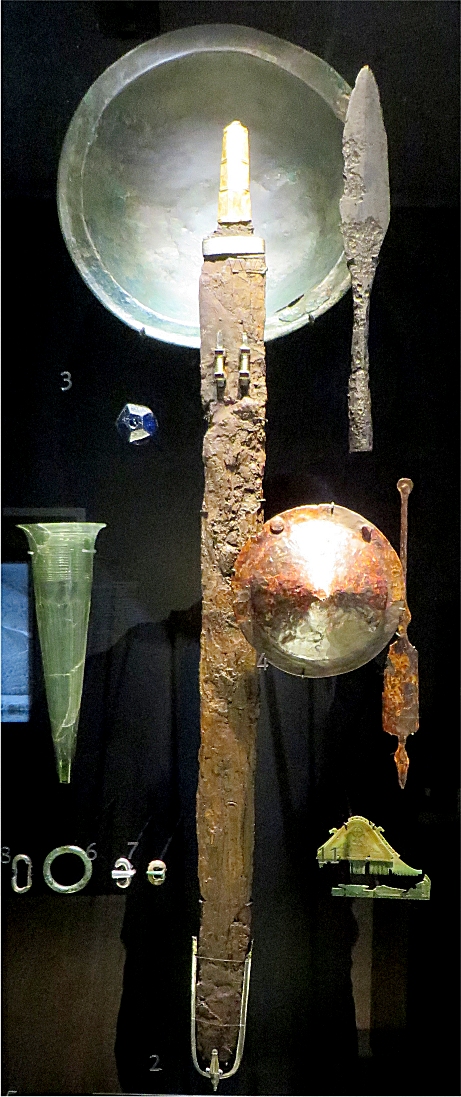 |
 |
| Link to text
Source: Photographed 2015 in the Württemberg State Museum, Germany |
|
| |
| |
|
 |
The first Gültlingen gold-hilt spatha: |
| | |
|
|
|
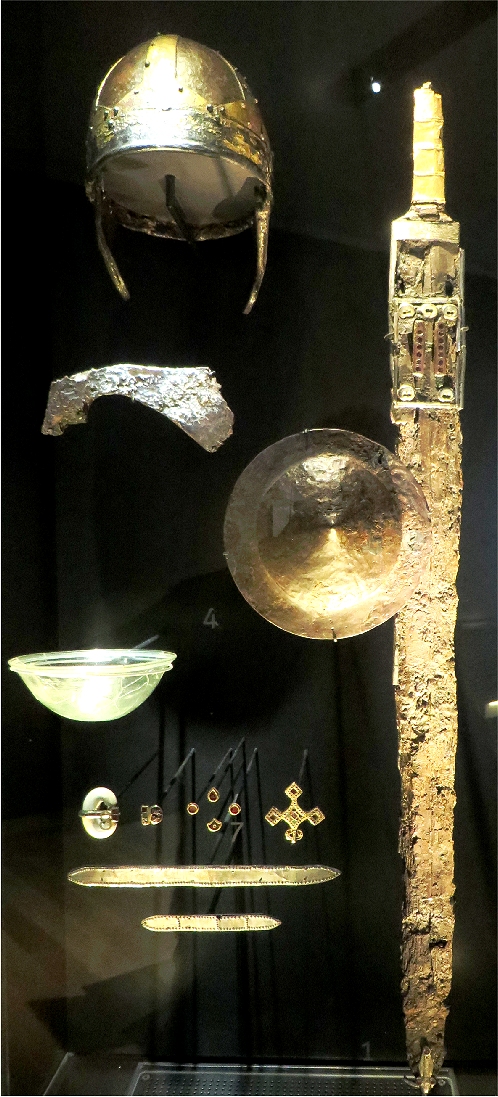 |
 |
| Link to text
Source: Photographed 2014 in the Württemberg State Museum, Germany |
|
| |
| |
|
 |
The second Gültlingen gold-hilt spatha: |
| | |
|
|
|
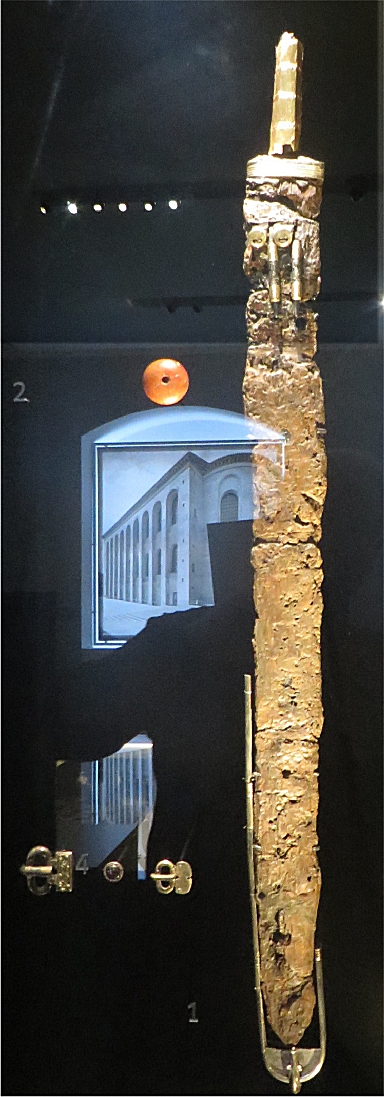 |
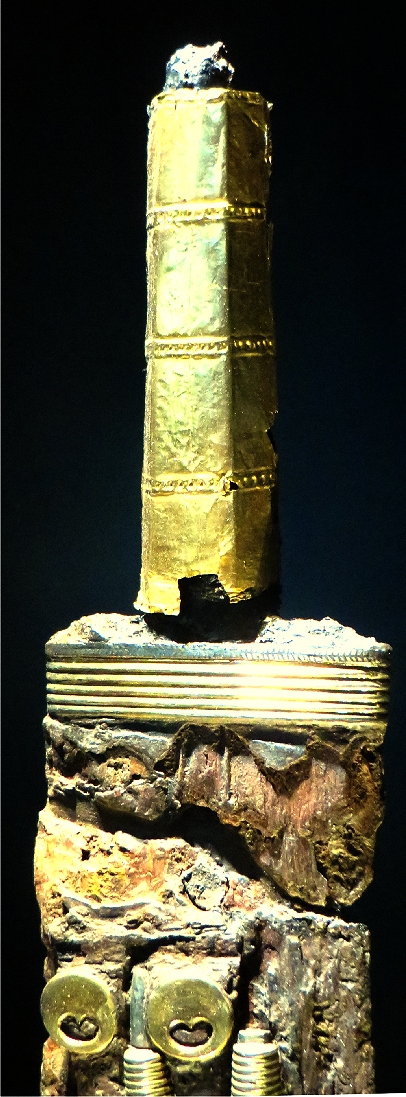 |
| Link to text
Source: Photographed 2014 in the Württemberg State Museum, Germany |
|
| |
| |
|
 |
The fourth gold-hilt spatha from Pleidelsheim: |
| | |
|
|
|
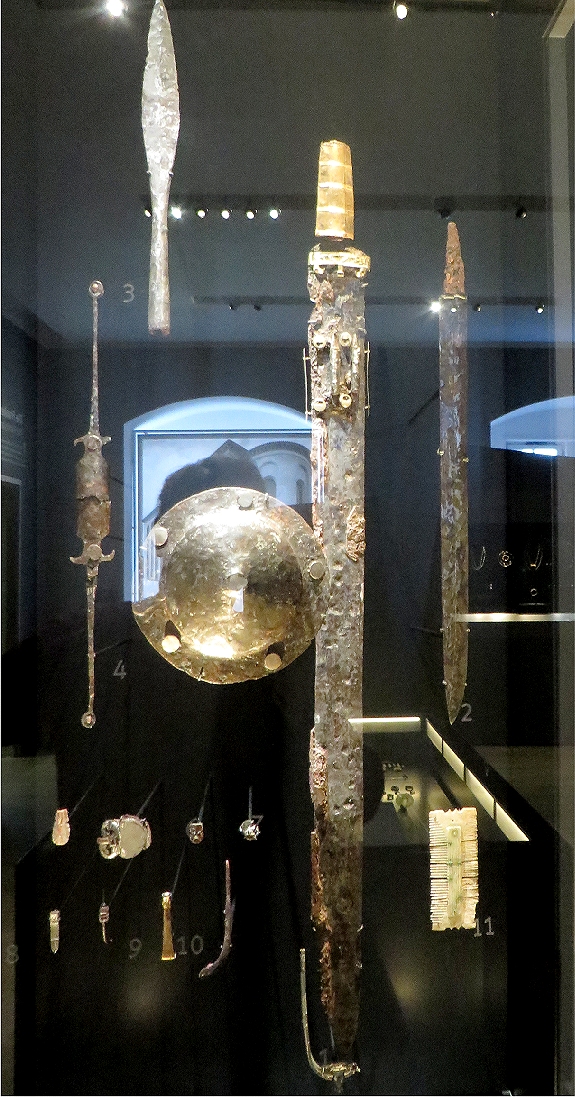 |
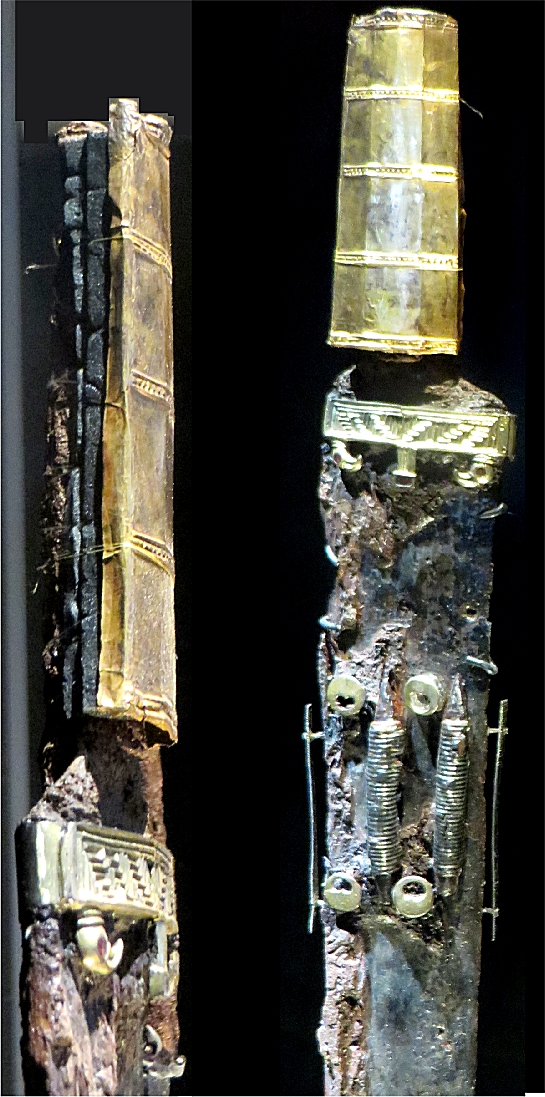 |
| Link to text
Source: Photographed 2014 in the Württemberg State Museum, Germany |
|
| |
| |
| 1) |
Ulrich Lehmann: "Wurmbunte Klingen. Studien zu Konstruktion, Herstellung
und Wertigkeit der frühmittelalterlichen Spatha in Westfalen"
Veröffentlichungen der Altertumskommission
für westfalen Landschaftsverband Westfalen-Lippe Band 21; herausgegeben von Aurelia Dickers.
Aschendorff Verlag
20176 |
 With frame
With frame

 Books and Other Major Sources
Books and Other Major Sources
 Damascene Meanings
Damascene Meanings
 Fire Welding
Fire Welding

 Critical Museum Guide: Landesmuseum Württemberg; Württemberg State Museum, Stuttgart, Germany
Critical Museum Guide: Landesmuseum Württemberg; Württemberg State Museum, Stuttgart, Germany
 Critical Museum Guide: Museums in Copenhagen
Critical Museum Guide: Museums in Copenhagen
 Critical Museum Guide: Landesmuseum Schleswig-Holstein in Schleswig, Germany
Critical Museum Guide: Landesmuseum Schleswig-Holstein in Schleswig, Germany
 Critical Museum Guide: "The Vikings" Special Exhibition from Oct. 2014 - Jan. 2015 in the Martin-Gropius-Bau
Critical Museum Guide: "The Vikings" Special Exhibition from Oct. 2014 - Jan. 2015 in the Martin-Gropius-Bau
 11.2.3 Roman Swords
11.2.3 Roman Swords
 Nydam
Nydam
 Danish Bog Sacrifices
Danish Bog Sacrifices
 11.4.2 Blades of Viking Era Swords
11.4.2 Blades of Viking Era Swords
 Sword Polishing and Revealing the Pattern / Structure
Sword Polishing and Revealing the Pattern / Structure
 11.3.3 Evolution of Pattern Welding
11.3.3 Evolution of Pattern Welding
 "Damascene" Patterns
"Damascene" Patterns
 Illerup Swords with Special Patterns
Illerup Swords with Special Patterns
 Migration Period Swords and Fancy Hilts & Pommels
Migration Period Swords and Fancy Hilts & Pommels
 Northern Sword Types of the First Millennium
Northern Sword Types of the First Millennium
 10.5.4 Making Steel Things
10.5.4 Making Steel Things
 Serpent in the Sword
Serpent in the Sword
 Käthe Harnecker and Wootz Blades
Käthe Harnecker and Wootz Blades
 Additional Pictures
Additional Pictures
 Illerup Ådal
Illerup Ådal
 Radiographie Study of Pattern Welded Swords
Radiographie Study of Pattern Welded Swords
 Gemstones
Gemstones
 11.3.4 Metallography of Pattern Welded Swords
11.3.4 Metallography of Pattern Welded Swords
 The Anglo-Saxon cemetery at Dover Buckland, Kent, UK and the technology of some of the iron artefacts.
The Anglo-Saxon cemetery at Dover Buckland, Kent, UK and the technology of some of the iron artefacts.
 Additional Pictures - Chapter 11.1
Additional Pictures - Chapter 11.1
 Some Less Important
Some Less Important
 Maps of Various Cultures
Maps of Various Cultures
 Mythology of Wootz Swords: Cutting a Stone
Mythology of Wootz Swords: Cutting a Stone
 Wurmbunte Klingen. Studien zu Konstruktion, Herstellung und Wertigkeit der frühmittelalterlichen Spatha in Westfalen
Wurmbunte Klingen. Studien zu Konstruktion, Herstellung und Wertigkeit der frühmittelalterlichen Spatha in Westfalen
© H. Föll (Iron, Steel and Swords script)
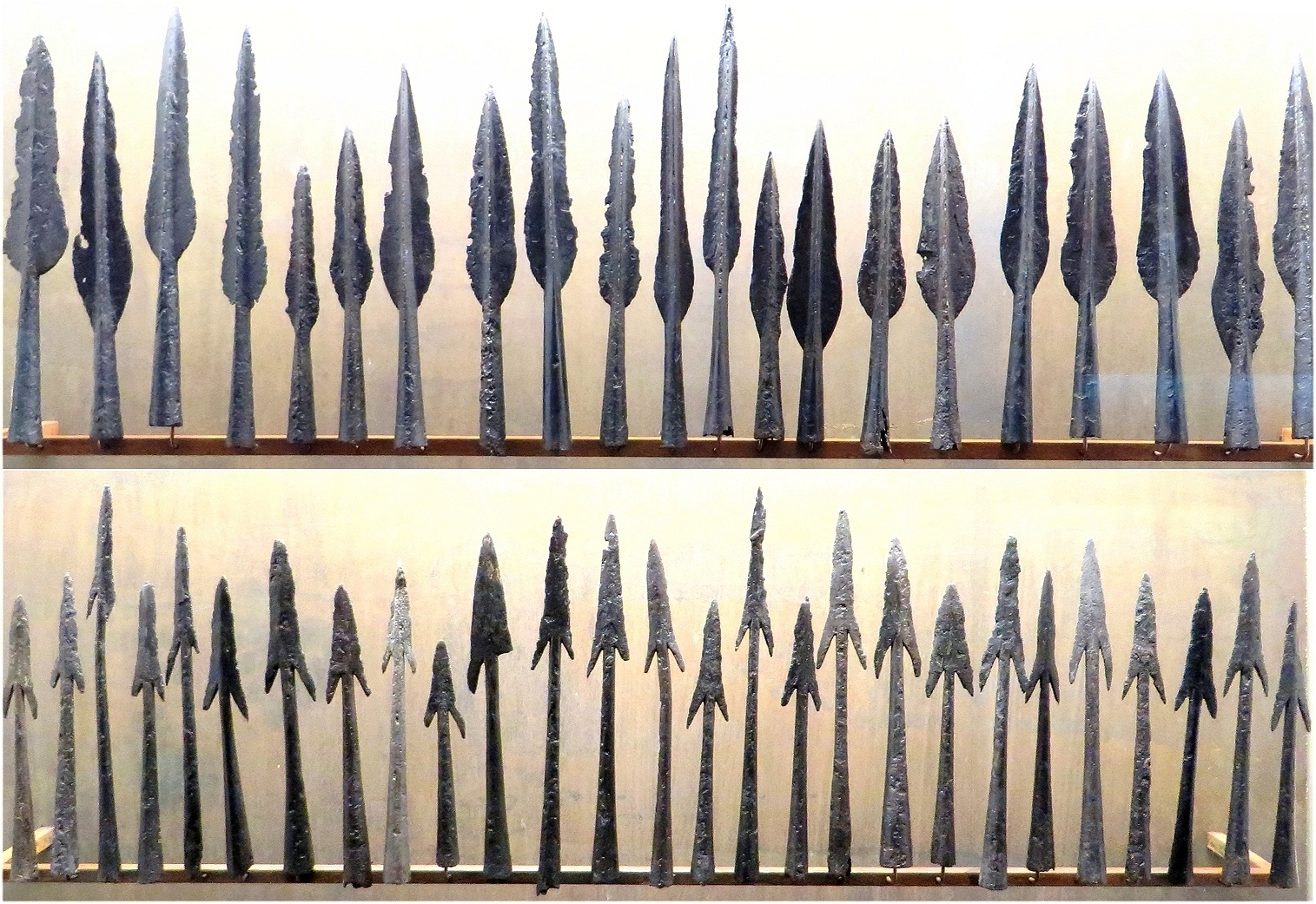
![]() Critical Museum Guide: Landesmuseum Württemberg; Württemberg State Museum, Stuttgart, Germany
Critical Museum Guide: Landesmuseum Württemberg; Württemberg State Museum, Stuttgart, Germany ![]() Critical Museum Guide: Museums in Copenhagen
Critical Museum Guide: Museums in Copenhagen ![]() Critical Museum Guide: Landesmuseum Schleswig-Holstein in Schleswig, Germany
Critical Museum Guide: Landesmuseum Schleswig-Holstein in Schleswig, Germany ![]() 11.4.2 Blades of Viking Era Swords
11.4.2 Blades of Viking Era Swords ![]() Sword Polishing and Revealing the Pattern / Structure
Sword Polishing and Revealing the Pattern / Structure ![]() 11.3.3 Evolution of Pattern Welding
11.3.3 Evolution of Pattern Welding ![]() Illerup Swords with Special Patterns
Illerup Swords with Special Patterns ![]() Migration Period Swords and Fancy Hilts & Pommels
Migration Period Swords and Fancy Hilts & Pommels ![]() Northern Sword Types of the First Millennium
Northern Sword Types of the First Millennium ![]() Käthe Harnecker and Wootz Blades
Käthe Harnecker and Wootz Blades ![]() Radiographie Study of Pattern Welded Swords
Radiographie Study of Pattern Welded Swords ![]() 11.3.4 Metallography of Pattern Welded Swords
11.3.4 Metallography of Pattern Welded Swords ![]() Additional Pictures - Chapter 11.1
Additional Pictures - Chapter 11.1 ![]() Mythology of Wootz Swords: Cutting a Stone
Mythology of Wootz Swords: Cutting a Stone